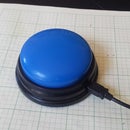Introduction: Laser Etched Wood Coasters
I made these coasters as a Christmas gift last year and an extra set for around the house. They are a bit time consuming since you'll need to seal them after etching but well worth the extra effort. I made it at the TechShop in San Francisco.
You will need:
* Access to a laser cutter
* 1/4" wood sheet. I used plywood laminated with cherry from MacBeath Hardwood in Berkeley. Laminates are cheaper than solid hardwood and you won't see the plywood edges since they'll be charred by the laser.
* Scrap cardboard
* Box of nails
* Exacto knife
* Paint brush
* Wood stain (optional)
* Polyurethane (or other protective sealant)
* 200 grit sandpaper
* Mineral spirits (or other solvent for cleanup)
Step 1: Design Your Coasters
You'll need to design your coasters using vector graphics software like Adobe Illustrator or CorelDraw. You can use the attached file as a starting point.
Start by creating 4" squares with rounded corners that will be the outline. Add a border inside the perimeter, this will hide the smoke stains from cutting out the coasters. Finally, add your design in the empty area. You can create your own or import an image. If you want a cut-out stenciled look, use a stencil font like Allerta Stencil, remove the fill and set a 0.001pt stroke. When you're happy with your designs, copy them into a grid the size of your laser bed.
Attachments
Step 2: Cut and Etch
Before cutting and etching your coasters, I would suggest running some tests to get the power settings right. You may also want to run some tests of your design on a scrap piece of cardboard. You can use the power test template in the AI file in the previous step. You will probably need to use multiple cutting passes to cut through the wood. On the Trotec in the TechShop it took me 2 passes at the plywood settings recommended in the design software.
When you have the power settings right, run the etch and cut job. Make sure your cuts went through before moving the sheet. Remove the coasters carefully and try to avoid getting any of the carbonized wood dust on the surface of the coasters.
Step 3: Seal the Coasters
Before using the coasters, you'll need to seal them. I used an oil based polyurethane and didn't stain them but you can choose a stain or sealant you prefer. Make sure you respect any VOC rules at your local TechShop.
Start by gently cleaning the surface of the coasters to remove any dirt and ash. I found that just wiping them with a clean cloth was enough. You can try rubbing alcohol, mineral spirits or another solvent but test first to ensure it doesn't effect the contract of the etched areas. Do not sand them unsealed, you will remove the etching.
Follow the directions for your stain (optional) and sealant. I did two coats with the polyurethane with a light sanding between. I used a sheet of cardboard with a grid of nails in it to hold the coasters and allow coating both sides each time.
When your sealant is dry, your coasters are ready to use!














